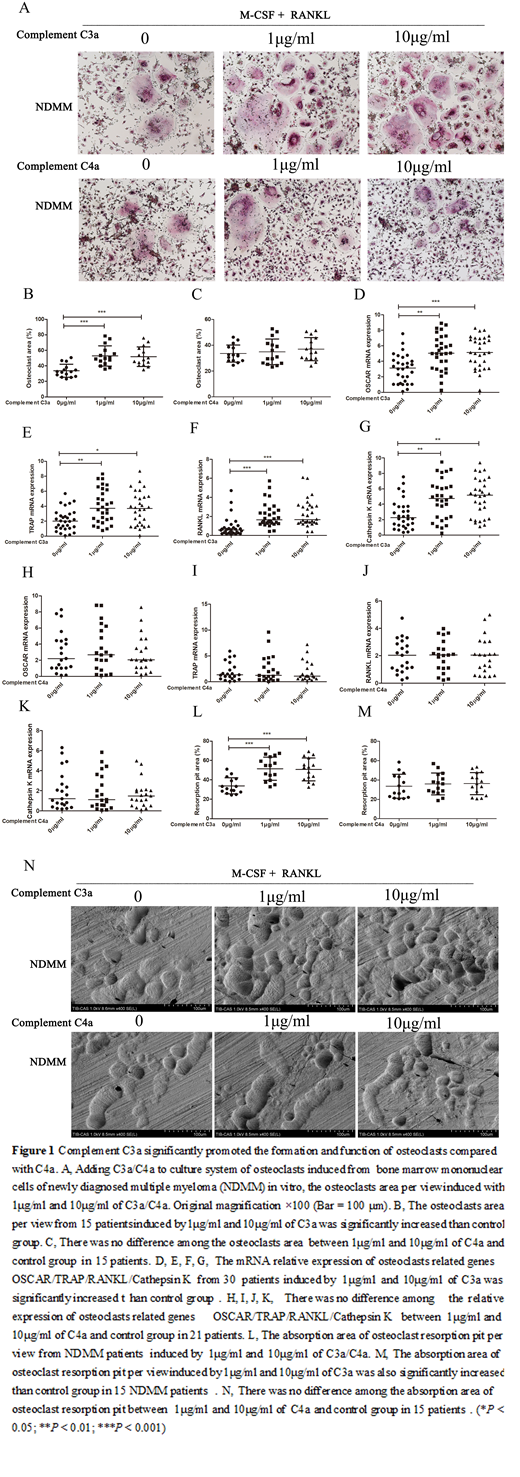Objective: Myeloma bone disease (MBD) is the most common complication of multiple myeloma (MM). We found that the serum levels of C3/C4 in MM patients were significantly positive correlated with the severity of bone disease in our previously study. Thus, we conduct detailed studies to explore the effect and potential mechanism of C3a/C4a on osteoclasts in patients with MM.
Methods: By adding C3a/C4a to culture system of osteoclasts induced from mononuclear cells in vitro, and the expression of related gene, number and function of osteoclasts were detected. RNA-Seq analysis was used to detect the differentially expressed genes on osteoclasts between the complement group and control group, and the possible signal pathways were analyzed. Quantitative real-time PCR (qRT-PCR), Western blot and pathway inhibitors were used for further validation.
Results: In vitro, the osteoclasts area per view induced by C3a 1μg/ml (52.794±13.027 %) and 10μg/ml (51.797±12.464 %) was significantly increased than control group (0μg/ml) (33.668±8.427 %) (P<0.001; P<0.001), the mRNA relative expression of osteoclasts related genes OSCAR/TRAP/RANKL/Cathepsin K induced by C3a 1μg/ml (median 5.041; 3.726; 1.638; 4.752) and 10μg/ml (median 5.140; 3.702; 2.250; 5.172) was significantly increased than control group (0μg/ml) (median 3.137; 2.004; 0.573; 2.257) (1μg/ml P=0.001; P=0.003; P<0.001; P=0.008; 1μg/ml P<0.001; P=0.019; P<0.001; P=0.002), and the absorption area of osteoclast resorption pit per view induced by C3a 1μg/ml (51.464±11.983 %) and 10μg/ml (50.219±12.067 %) was also significantly increased than control group (0μg/ml) (33.845±8.331 %) (P<0.001; P<0.001) in NDMM patients. There was no difference among the osteoclasts area, relative expression of osteoclasts related genes and absorption area of osteoclast resorption pit between C4a (1μg/ml and 10μg/ml) group and control group (0μg/ml).
RNA-Seq was performed on total RNA of osteoclasts induced by C3a in 1μg/ml group and 0μg/ml group of 4 patients with NDMM. There were 184 differentially expressed genes that were detected by RNA-Seq analysis. KEGG Pathway enrichment bubble chart shows C3a may through Phosphoinositide 3-kinase (PI3K) signaling pathways (including PI3K-Akt pathway and AKT-independent signaling pathway) promotes the proliferation of osteoclast. Upregulated differentially expressed genes in this pathway among at least 3 patients with sequencing were validated by qRT-PCR and Western Blot. It was found that the relative expression level of Phosphoinositide dependent kinase-1 (PDK1) / Serum and glucocorticoid inducible protein kinases (SGK3) genes (median 2.078; 4.428) in C3a group (1μg/ml) was significantly higher than control group (0μg/ml) (median 1.336; 1.714) (P<0.001; P=0.001). The relative grayscale levels of PDK1/ P-SGK3 protein (1.785±0.323; 2.190±0.274) in C3a group (1μg/ml) was significantly stronger than control group (0μg/ml) (0.8653±0.588; 0.176±0.152) (P=0.034; P<0.001). Under the action of C3a in patients with NDMM, osteoclasts area per view in SGK inhibitor (EMD638683) 1μM group (39.244±9.089 %) and 10μM group (39.299±9.587 %) significantly reduced than control group (0μM) (54.884±12.837 %) (P<0.001; P<0.001), the relative expression of osteoclast related genes OSCAR/RANKL/TRAP/Cathepsin K in EMD638683 1μM group (median 0.869; 1.097; 0.902; 1.328) and 10μM group (median 0.703; 1.391; 0.843; 1.418) significantly decreased than control group (0μM) (median 2.270; 3.024; 2.208; 3.237) (1μM P=0.015; P=0.002; P=0.003; P=0.015; 10μM P=0.012; P=0.006; P<0.001; P=0.017), and the absorption area per view of osteoclast resorption pit in EMD638683 1μM (35.383±7.794 %) group and 10μM group (32.886±8.993 %) significantly reduced than control group (0μM) (49.358±11.856 %) (P < 0.001; P < 0.001).
Conclusions:ComplementC3a activates osteoclasts by regulating the PI3K/PDK1/SGK3 pathway in patients with MM, thus leading to the occurrence of bone diseases. SGK inhibitor has a significant inhibitory effect on osteoclasts in patients with MM. This study provide important evidences for the search for new therapeutic targets and strategies for myeloma bone disease patients.
No relevant conflicts of interest to declare.
Author notes
Asterisk with author names denotes non-ASH members.


This feature is available to Subscribers Only
Sign In or Create an Account Close Modal